Grand Cru Schoenenbourg SVCB A 686 Haut-Rhin 2011
Alsace AOC
Francja
Riesling
Cena: 40
Alk: 13,50%
Kolor: b
Ocena: 6
Nr 14821
www
| 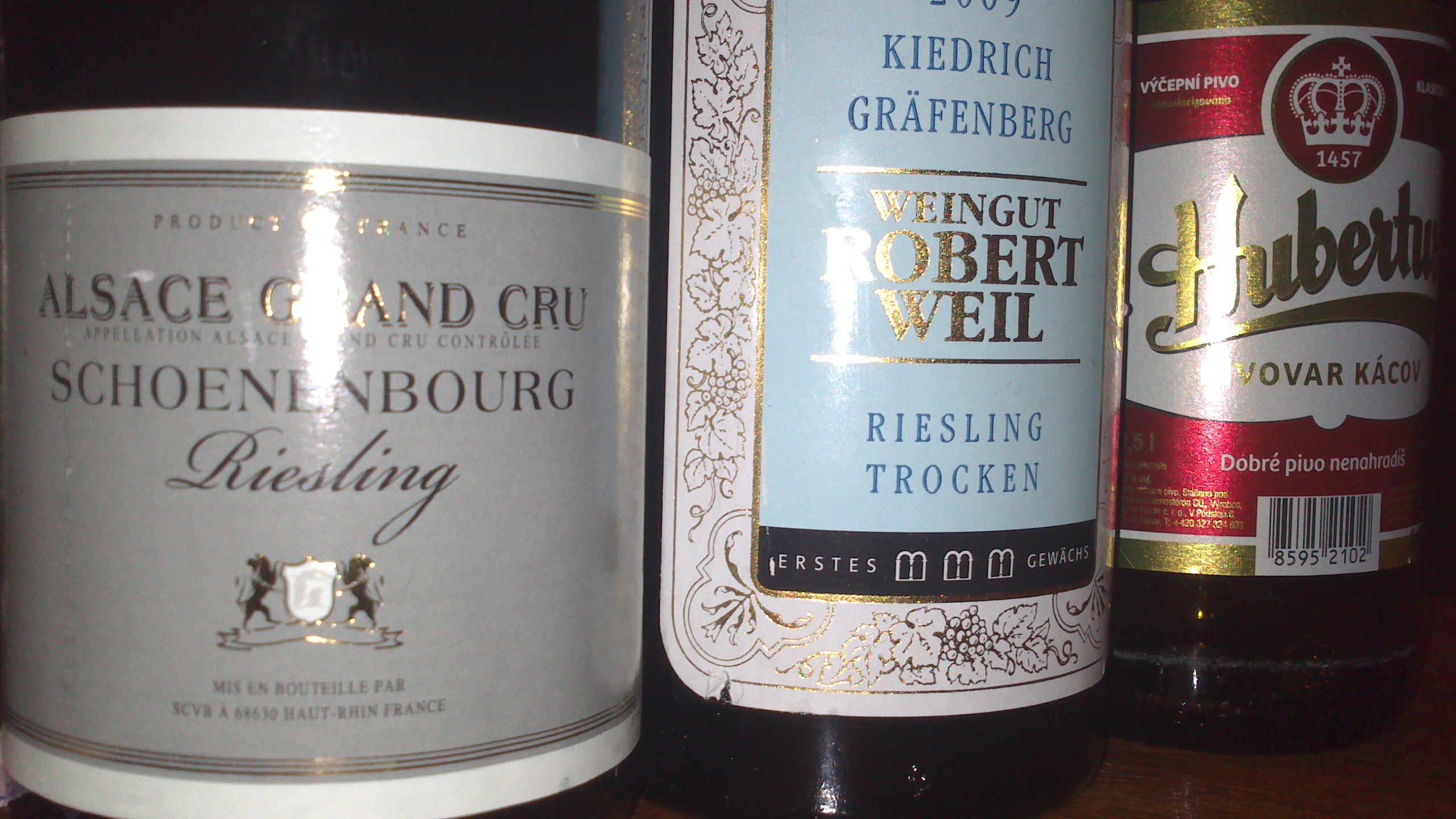 | star (2013-12-02)   
Riesling na bogato. Do pikantnych ķledzi poszģo. Owocowo.pl. @Lidl
star (2013-12-10)
No czort wie. Syndicat de bouilleur de cru to miaģa byæ zabawna alternatywa dla czegoķ w stylu Societe Vinicole de Caves de B...heim np. Bebleheim;)
wino14821#49264 Amsti (2013-12-10)
No ja bym obstwiaģ, ŋe ten Mambourg to byģ Pinot Gris, bo Riesling tyŋ nie (brak cech charakterystycznych i niska kwasowoķæ).
Które wyjaķnienie skrótu zatem moŋna przyjąæ? Nie jest to chyba kooperatywa Bestheim, bo oni do Lidla pchają swoje butelki z wģasnymi etykietami.
wino14821#49263 star (2013-12-08)
Dzięki za polecanie producentów:-)
wino14821#49254 ducale (2013-12-08)
@sstar kup sobie z tego Grand Cru Doppfa, Hugela to się przekonasz na czym polega róŋnica. W necie Ci nie wytģumaczę
wino14821#49252 star (2013-12-07)
Tģumaczenia SVCB mogą byæ róŋne, niektóre doķæ przewrotne, jak to (pralinka) które o domowych dystylarniach mówią, a tu tģumacz Google (pralinka) Kiedy destylator destyluje swój bimber:-)D'abord, il y a le cas tout particulier des habitants de l'Alsace et de la Lorraine qui n'ont pas connu le régime de Vichy et la loi du -sauf erreur- 2 juillet 1941 qui interdit la distillation ? domicile (et la possession par le bouilleur de cru d'un alambic). Cette loi séparera définitivement les bouilleurs de cru (les producteurs) et les bouilleurs ambulants (les distillateurs). Dans ses régions épargnées par Vichy, le bouilleur de cru a toujours le droit de distiller lui-m?me son cru avec son propre alambic (ou un pareil loué pour une journée par un "loueur d'alambic ambulant"). Il faut remarquer que c'est dans ces régions que la tradition s'est le mieux conservé, c'est aussi l? qu'elle a le mieux évolué (la distillation dite "moderne" y r?gne plus que partout ailleurs en France), ce qui indique que la production de l'eau-de-vie est mieux protégé lorsque c'est la m?me personne qui s'occupe de son verger, de son tonneau, et de son alambic (mais pour s'occuper de boire le fruit de ce noble travail, il vaut mieux que ce ne soit pas forcément toujours la m?me personne?).
wino14821#49244 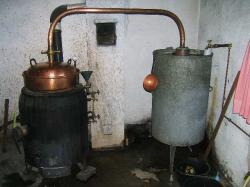 star (2013-12-06)
A o Mambourgu tutaj (pralinka) na Wine Searcherze piszą, moŋe im Rieslinga czy Muscata trochę wpadģo;-)Mambourg Wine
Mambourg is an Alsace Grand Cru vineyard in the commune of Sigolsheim in Alsace, north-eastern France. At roughly 153 acres (62ha) it is one of the largest of Alsace's 51 Grand Cru sites.
Mambourg is one of a quartet of Grand Crus located on the northern slopes of the Weisbach valley, at the heart of Alsace. Schlossberg, Furstentum and Marckrain are the other three in this group, which is significant because of the degree to which the vineyards' south-facing slopes extend out onto the plains north of Colmar.
Mambourg Grand Cru
( CIVA / Z Vardon)
The majority of Alsace's Grand Cru sites closely hug the lower slopes of the Vosges Mountains, away from the over-fertile soils of the alluvial plains. They are generally restricted either to incidental south-east-facing slopes or to south-facing slopes on finger-like promontories. The unbroken south-facing slope which runs west-east for three miles (4.8km) from Kayserberg to Bennwihr is therefore something of an exception. The ridge stands so prominently over the landscape that it has long been the chosen location for watch towers and fortresses. Today it is the site of the international Sigolsheim WW2 memorial and French national cemetery. Mambourg is located at the eastern end of this slope, known as the Blutberg ('Hill of Blood') and as Hill 216.
The Mambourg slopes rise steadily from 690 to 1150ft (210–350m). They have a southerly aspect, meaning that the vines are exposed to the ripening rays of the sun in the late morning and throughout the afternoon. As the promontory reaches its apex, the slopes sweep around to the north; this section is within the commune boundaries of Bennwihr, and is thus a part of the adjacent Marckrain Grand Cru site. The soils on both of these sites are composed of a rough mixture of limestone and marlstone, mixed in with granitic, magnesium-rich sand.
The climate of the area is of continental type with particularly low rainfall – a result of the rain shadow cast by the Vosges. The mountains also provide protection from the prevailing westerly winds, making the Alsatian summer one of the driest and warmest in the northern half of France. At the other end of the temperature scale, the winters here are cold; it is not uncommon to see Alsace vineyards lined with snow.
Apart from a few notable exceptions, all Alsace Grand Cru wines are varietals and may be made from Riesling, Gewurztraminer, Pinot Gris or Muscat. Mambourg has each of these planted, although Gewurztraminer is the variety best suited to the site.
Photo CIVA / Z Vardon.
wino14821#49241 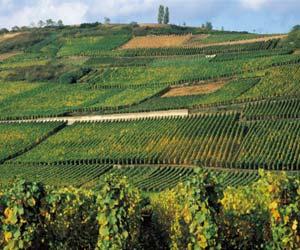 star (2013-12-06)
Mambourg mówisz? Moŋe to byģ Pinot. Jako rzecze (pralinka) Marcel Deiss. Dominant SIGOLSHEIM, the MAMBOURG is the most precocious hillside among the vineyards. Known since the Middle Ages, many monasteries and lords had owned this land and gave it their credentials. Beneficing from a maximum duration of sunshine, its magnesium soil grows on the conglomerated limestone and marl hills of Tertiary Era. This particular geology from Quaternary Oligocene limestone grants MAMBOURG a very rare characteristic: powerful tannins always presented and a round smooth in the palate. Our low-trained vines, planted with all the Pinots in an intensity of 12 700 vine/hectare, produce between 15 and 20 hl / ha: wines are always perfectly dry with an exaggerated power and an extreme complexity. Ageing Potential: 15 to 20 years
wino14821#49240 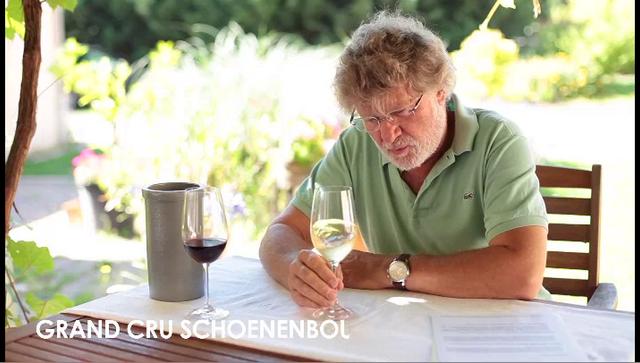 star (2013-12-06)
A co do Grand Cru Schoenenburg, to wrzucę trochę info moŋe z Wiki. Przy okazji polecam ksiąŋkę: Stevenson, Tom (1993). The Wines of Alsace. Faber & Faber.
The Alsatian Grand Cru vineyard Schoenenbourg is situated north of the village Riquewihr. The vineyard faces south and south-east on the steep hill Schoenenbourg. The altitude of the vines are between 265 and 380 meters and covers 53.4 ha og Keuper subsoil with marl, gypsum and dolomite.
Viticulture at Schoenenbourg goes back hundreds of years. The philosopher Voltaire owned vineyards at the site and the wine from Schoenenbourg was admired throughout northern Europe. While the Grand Cru designation was being developed in the 1970s, Schoenenbourg was not to wear those laurels until a decree in 1992.
Descending into Riquewihr through vineyards - photo.
wino14821#49239 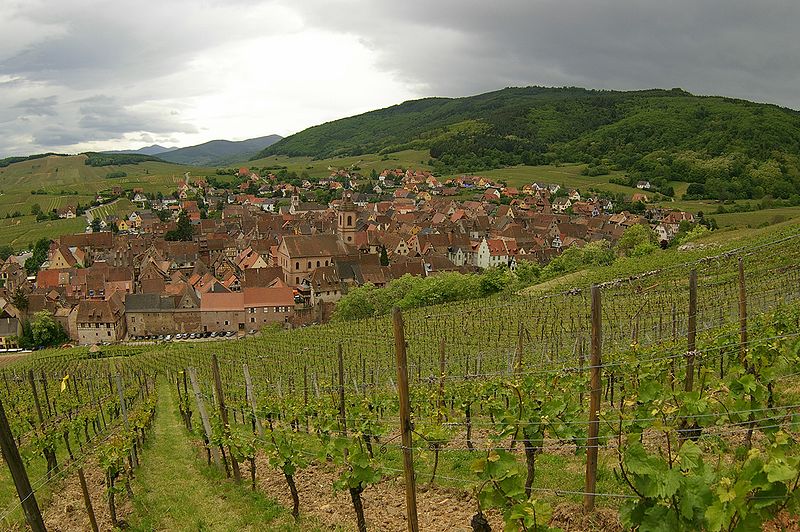 star (2013-12-06)
Wodniste to rozumiem. Moja flaszka taka wg mnie nie byģa, a piģem w zestawie, z EG Weila. Nie do koņca rozumiem natomiast co chcesz Ducale powiedzieæ o Grand Cru, ŋe nie odpowiada twojemu wyobraŋeniu, poziomowi tego typu win, czy teŋ masz jakieķ punkty odniesienia do Schoenenburga i do tego pijesz?
wino14821#49238 marwin (2013-12-06)
@Amsti Opowiadaģ mi kiedyķ kolega, ŋe jego brat pracowaģ w Niemczech w rozlewni wina, gdzie zdarzyģa się taka sytuacja. Ktoķ odpowiadający za to, co byģo lane do butelek, zauwaŋyģ, ŋe etykiety na butelkach dotyczą merlota, a od godziny leją caberneta. Ponoæ kierownik stwierdziģ - O.K., kto to zauwaŋy ? Moŋe Twój Gewurz powinien mieæ po prostu inną etykietę ? Moŋe rozlewnia/zlewnia byģa ta sama ?
wino14821#49237 amsti (2013-12-05)
W ogóle to caģe SVCB to ciekawostka, co to jest, ktoķ butelkuje dla Lidla i ukrywa się pod tym skrótem? Bo ja poza Lidlem (takŋe u somsiadów poģudniowych) tego nie widziaģem nigdzie indziej. Jak ten riesling to nie wiem, ale w zeszģym roku piģem coķ co zwaģo się Gewurztraminer Grand Cru 2010, w dodatku Mambourg (tak, mi teŋ kojarzyģo się z Weinbach), byģo dobre, tyle, ŋe naturalnego qnia z rzędem temu, kto by w ciemno zgadģ, ŋe to Gewurz. Tak atypowego nie piģem nigdy wczeķniej. Nie wiem co to byģo, moze im się etykietki pomieszaģy. W tym roq jest w oferie 2011 Marckrain zdaje się.
wino14821#49236 ducale (2013-12-05)
Kupiģem to wino w ub. tygodniu, bodajŋe pierwsze w ŋyciu w Lidl. No more.Sģabe, wręcz wodniste powiem, nie ma nic wspólnego z siedliskiem Schoenenbourg
wino14821#49235 star (2013-12-04)
Rozumiem i z potrzebą kwasowoķci w winie zgadzam się w peģni choæ bywaģo, ŋe w niektórych delikatna goryczka wspóģgrająca ze sģodyczą kompensowaģa brak kwasowoķci, czy teŋ raczej niski jej poziom. W tym przypadku tak jednak nie byģo - kwasowoķæ byģa wystarczająca, a wino dojrzaģe, a raczej winogrona;-)
wino14821#49212 marwin (2013-12-02)
@Star Jak napisaģem, wino byģo smaczne. Tak jak piszesz o swoim - treķciwe. Ale bogactwo aromatów i smaku, to dla mnie za maģo. Brak kwasu szybciej wybaczam czerwonym niŋ biaģym. To wino byģo dla mnie jak kwiat, który szybko usechģ, bo zabrakģo mu wody (czyt. kwasu)
wino14821#49209
Wina SVCB A 686 Haut-Rhin:
Grand Cru Schoenenbourg 2011 A..
Grand Cru Marckrain 2011 Alsac..
|






